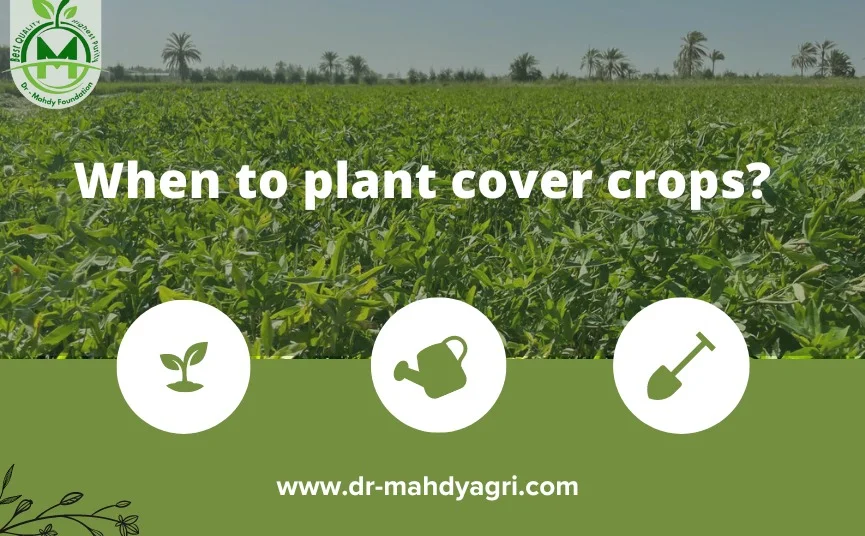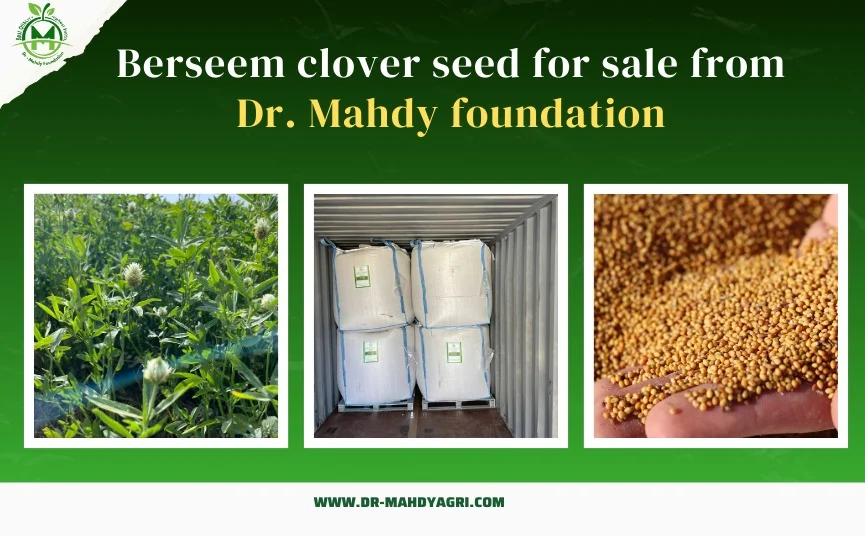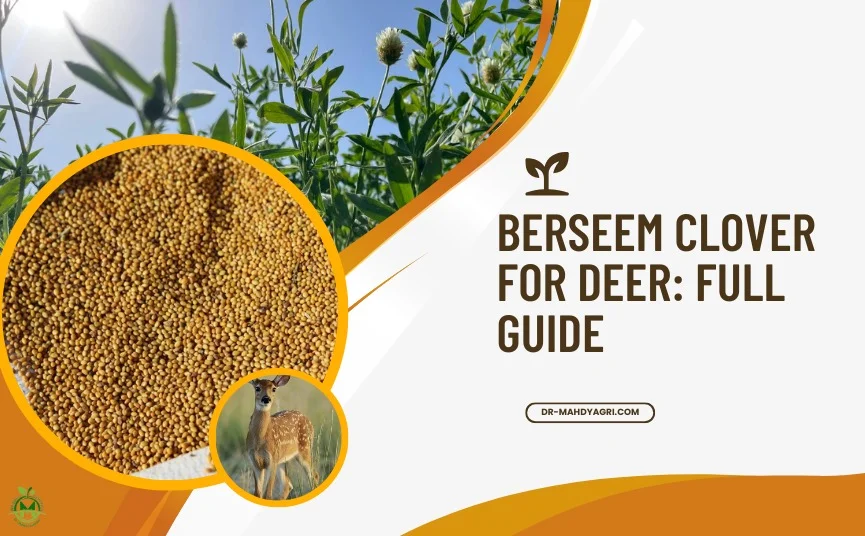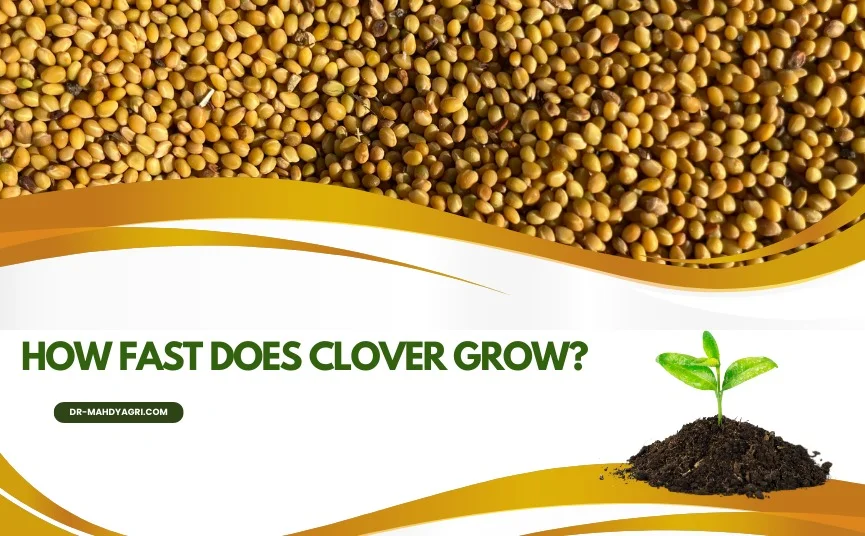

Berseem clover (Trifolium Alexandrinum) is a legume cover crop that originated in Egypt and is widely grown throughout the Mediterranean region. It is also called Egyptian clover, Balady clover, and Bigflower clover. Berseem clover offers numerous benefits as a cover crop, including rapid growth and a high biomass yield.
Berseem Clover as Cover Crop: A Guide for Farmers
Berseem Clover as a Cover Crop thrives in a variety of environments and is a valuable resource for ecosystems and agriculture. It extracts nitrogen from the air, which enriches the soil with vital organic matter. Its dense canopy suppresses weeds and effectively competes for nutrients. Furthermore, it endures harsh winter conditions, including frost and snow. Finally, Berseem Clover as a Cover Crop supplies nutritious food for both livestock and wildlife.
In this article, we will discuss the benefits of using Berseem clover as a cover crop, how to grow it, and some common challenges with solutions.
Read More:
when to plant cover crops
berseem clover seed for sale
berseem clover annual or perennial
Benefits of Berseem Clover as Cover Crop
Berseem clover is a versatile and beneficial cover crop that can improve soil health, suppress weeds, and provide forage. Here are some of the main benefits of berseem clover as a cover crop:
Soil Health Improvement
Berseem Clover as Cover Crop is a legume capable of fixing nitrogen from the air and transferring it to the soil. Nitrogen is a key nutrient for plant growth and crop yield. Berseem clover can fix up to 200 pounds of nitrogen per acre, depending on the variety, growth stage, and environmental factors. This can reduce the need for synthetic nitrogen fertilizers, lowering production costs.
Berseem Clover as Cover Crop also produces a large amount of biomass, which can be added to the soil as organic matter. Organic matter can help improve soil structure, water retention, drainage, aeration, and fertility. It can also boost the activity and diversity of soil microorganisms like bacteria, fungi, and earthworms, which break down organic matter and release nutrients.
Weed Suppression
Berseem Clover as Cover Crop is a rapidly growing cover crop that can compete with weeds for light, water, and nutrients. It can form a dense canopy that shades the soil and inhibits weed germination and growth. Berseem Clover as Cover Crop can also produce allelopathic substances that prevent the growth of certain weeds, including crabgrass, foxtail, and pigweed.
Berseem clover can reduce weed pressure and the need for herbicides in the subsequent crop. This can save time, money, and labor while also reducing the environmental impact of herbicide use.
Read More: Berseem Clover Forage
Forage Production
Berseem Clover as Cover Crop is an excellent and palatable forage for livestock and wildlife. It contains a high crude protein content (up to 25%) and is highly digestible (up to 75%). It can be grazed, hayed, or silaged, depending on management objectives and preferences.
Berseem Clover as Cover Crop can provide forage in the fall, winter, and spring, depending on the planting season and variety. It can lengthen the grazing season while reducing the need for stored feed. It can also attract and support wildlife, including deer, turkeys, and quails, by providing food and shelter.
Everything you want to know about Berseem Clover Balady
How to Grow Berseem Clover as Cover Crop?
Berseem Clover as Cover Crop is a relatively easy cover crop to grow, but it requires some planning and management. Here are some of the key steps and considerations for growing Berseem clover as a cover crop:
-
Choose the Right Variety
Berseem clover has many varieties that differ in their growth habits, maturity, winter hardiness, and disease resistance. Some of the common varieties are:
-
Bigbee: This winter-hardy variety can withstand temperatures as low as -10°F. It has a semi-erect growth habit and matures in 60-70 days. It is resistant to root knot nematodes and Fusarium wilt.
-
Frosty: This winter-hardy variety can withstand temperatures as low as -5°F. It has a prostrate growth habit and matures in 50-60 days. It is resistant to root knot nematodes and Fusarium wilt.
-
Joe Burton: This winter-hardy variety can withstand temperatures as low as 0°F. It has a semi-erect growth habit and matures in 70-80 days. It is resistant to root knot nematodes and Fusarium wilt.
-
Multicut: A non-winter hardy variety capable of producing multiple cuttings or grazings. It grows semi-erect and matures between 40 and 50 days. It is vulnerable to root-knot nematodes and Fusarium wilt.
The planting date, climate, intended use, and seed availability all influence the variety selected. In general, winter-hardy varieties are preferred for autumn planting, while non-winter-hardy varieties are preferred for spring planting.
Read More:
Berseem clover for deer
how fast does clover grow?
berseem clover vs balansa clover
2. Prepare seedbed of barseem
Berseem Clover as Cover Crop can grow in a variety of soil conditions, but it prefers well-drained, fertile, and slightly acidic soils (pH 6.0 to 7.0). It cannot tolerate saline, alkaline, or waterlogged soils. To create a fine and firm seedbed, prepare it by plowing, disking, or harrowing. To optimize soil pH and fertility, test it and add lime, fertilizer, or manure as needed.
3. Plant the Seeds
Berseem Clover as Cover Crop can be planted using broadcasting, drilling, or no-till methods. The seeding rate varies depending on the variety, planting method, seed purity, and germination. Seeding rates typically range from 15 to 25 pounds per acre for broadcasting, 10 to 20 pounds per acre for drilling, and 20 to 30 pounds per acre for no-till seeding. The seeding depth should be 1/4 to 1/2". To ensure effective nitrogen fixation, inoculate the seeds with the appropriate Rhizobium strain.
The planting date varies according to the variety, climate, and intended use. Berseem Clover as Cover Crop is typically planted from late summer to early fall (August to October) for fall and winter forage, or from late winter to early spring (February to April) for spring and summer forage. The planting date should be adjusted to avoid extreme heat, drought, or frost.
Read More about
berseem clover seed non gmo
berseem clover scientific name
Manage Growth for barseem
Berseem Clover as Cover Crop is a low-maintenance cover crop that does not require much irrigation, fertilization, or pest control. However, some management practices can enhance its growth and performance, such as:
-
Irrigation: Berseem clover is moderately drought-tolerant, but it performs better with adequate moisture. Irrigation may be needed during dry spells or in arid regions. The soil moisture should be maintained at 50 to 75% of the field capacity.
-
Fertilization: Berseem clover can fix its own nitrogen, but it may benefit from phosphorus and potassium fertilization, especially in low-fertility soils. A soil test can determine the optimal fertilizer rate and timing. Generally, 40 to 60 pounds of phosphorus and 60 to 80 pounds of potassium per acre are recommended at planting or soon after emergence.
-
Pest Control: Berseem clover is relatively resistant to most pests and diseases, but it may be affected by some insects, nematodes, fungi, and viruses. Some of the common pests and diseases are aphids, leafhoppers, root-knot nematodes, fusarium wilt, anthracnose,and mosaic virus. Pest and disease pressure can be reduced by choosing resistant varieties, rotating crops, and using integrated pest management practices.
Read More: Berseem Clover for Cattle
Harvest or Terminate Crop barseem
Berseem clover as Cover Crop can be harvested or terminated depending on the intended use and the following crop. Here are some of the options and considerations for harvesting or terminating berseem clover:
-
Grazing: Berseem clover can be grazed by livestock or wildlife when it reaches 6 to 8 inches in height. It can be grazed multiple times until it flowers or until the soil temperature reaches 85°F. Grazing should be managed to avoid overgrazing, bloat, or nitrate poisoning. Grazing can also help terminate the crop by reducing its biomass and vigor.
-
Haying or Silaging: Berseem Clover as Cover Crop can be hayed or silaged when it reaches 10 to 12 inches in height or 50% flowering. It can be cut multiple times until it flowers or until the soil temperature reaches 85°F. Haying or silaging can provide high-quality feed for livestock or wildlife. Haying or silaging can also help terminate the crop by reducing its biomass and vigor.
-
Mowing or Rolling: Berseem Clover as Cover Crop can be mowed or rolled when it reaches 50% flowering or before the following crop is planted. Mowing or rolling can help terminate the crop by cutting or crushing its stems and leaves. Mowing or rolling can also help incorporate the crop residue into the soil as organic matter.
-
Herbicide Application: Berseem clover can be killed by applying a non-selective herbicide, such as glyphosate, when it reaches 50% flowering or before the following crop is planted. Herbicide application can ensure a complete termination of the crop and prevent any volunteer plants or seed production. Herbicide application should be done according to the label instructions and safety precautions.
Common Challenges and Solutions for Growing Berseem Clover as Cover Crop
Berseem clover is a relatively easy cover crop to grow, but it may face some challenges and limitations, such as:
1. Seed Availability and Cost
Berseem clover is not a widely grown cover crop in the US, and its seed availability and cost may vary depending on the region, the season, and the demand. The seed cost may range from $2 to $4 per pound, depending on the variety and quality. The seed availability and cost can be improved by sourcing the seeds locally, buying in bulk, or saving the seeds from the previous crop.
2. Establishment and Competition
Berseem clover is a fast-growing cover crop, but it may face some challenges in establishing and competing with other plants, such as:
-
Residue Interference: Berseem clover may have difficulty in germinating and emerging through a thick layer of crop residue, especially in no-till systems. The residue interference can be reduced by using a higher seeding rate, a drill seeder, or a residue manager.
-
Shade Tolerance: Berseem clover may have difficulty in growing under a dense canopy of the previous crop, especially in relay cropping systems. The shade tolerance can be improved by choosing a shade-tolerant variety, such as Frosty, or by planting earlier or later than the previous crop.
-
Companion Crops: Berseem clover may have difficulty in competing with other cover crops, especially grasses, in mixed or intercropped systems. The companion crops can be beneficial by providing diversity, stability, and synergy, but they can also be detrimental by reducing the growth, performance, and benefits of berseem clover. The companion crops should be chosen carefully and managed properly to achieve a balance between the benefits and drawbacks.
Winter Survival and Reseeding
Berseem clover is a winter-hardy cover crop, but it may not survive the winter in some regions or conditions, such as:
-
Low Temperature: Berseem clover may not survive the winter if the temperature drops below its tolerance level, which varies depending on the variety, the growth stage, and the snow cover. The low temperature can be mitigated by choosing a winter-hardy variety, such as Bigbee, Joe Burton, or Frosty, or by planting earlier to allow more growth and hardening before the winter.
-
High Temperature: Berseem clover may not survive the winter if the temperature rises above its tolerance level, which is around 85°F. The high temperature can cause the crop to flower prematurely and die, or to produce seeds and reseed itself. The high temperature can be avoided by planting later to delay flowering and senescence, or by terminating the crop before it produces seeds.
Conclusion
Berseem Clover as Cover Crop is a fast-growing, nitrogen-fixing, winter-hardy that can help with soil health, weed control, and forage production. It can be grown in a wide range of soil types, climates, and cropping systems. It can be harvested or destroyed through grazing, haying, silaging, mowing, rolling, or herbicide application. It may face some obstacles and constraints, such as seed availability and cost, establishment and competition, and winter survival and reseeding. However, these challenges and limitations can be overcome by selecting the appropriate variety, preparing the seedbed, planting the seeds, managing the growth, and harvesting or terminating the crop. you can call with Dr. Mahdy Best seller of Egyptian Berseem Clover seeds for cover crops>



